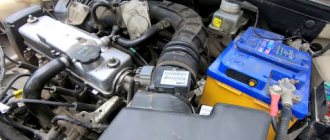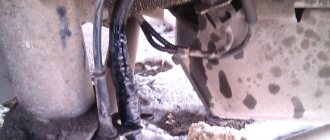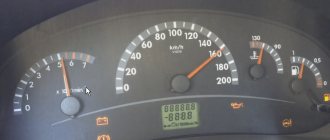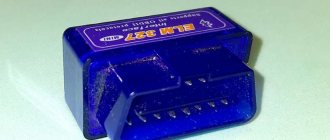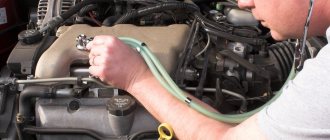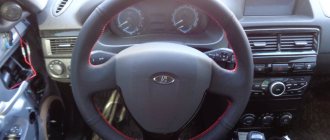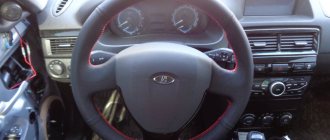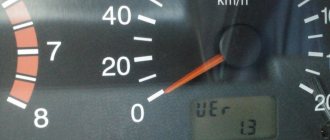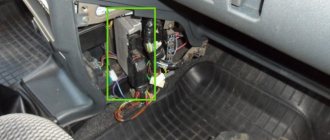Causes of malfunction
Motorists are wondering: why does the VAZ 2107 engine suffer from injector problems? Many owners of injection VAZ 2107 encountered the fact that the engine began to stall. This malfunction is typical for the entire family of Lada engines. What are the reasons for this effect and where to look for the problem:
- Fuel pump and filter.
- Injectors.
- Spark plugs and high-voltage wires.
- Air filter.
- Throttle.
- valves.
- ECU and sensors.
Solution methods
When the reasons for the throttling of the injection-type VAZ 2107 engine have been determined, you can proceed directly to analyzing options for eliminating the problem. Before you begin, you need to understand that you need to know the design features of the motor.
But the 2107 engine is so simple that even the most inexperienced motorist will figure out what’s going on. So, let's look at how to remove the injector tripping of a VAZ 2107 engine.
Fuel pump and filter
The first place to look for the cause begins with the fuel supply. First, you should check the fuel pump for functionality and whether there are any malfunctions. If this element does not show visible signs of damage, then it is recommended to disassemble it and check it.
Many experienced car enthusiasts advise, after the fuel pump, to start replacing the fuel filter element, since this is where fuel can poorly pass to the injectors. The fuel filter, according to the service documentation, must be changed every 30-35 thousand kilometers.
Injectors
The next place to look for trouble is the injectors themselves. They may be clogged due to the use of low-quality fuel or defective due to their service life, in other words, worn out.
The elements are checked using a special stand, which not only diagnoses the condition, but also cleans the elements. If there is a damaged or worn part, it is better to replace it with a new element.
Spark plugs and high voltage wires
Loss of spark can also lead to engine malfunction. The next unit that needs to be examined is the ignition. First of all, it is recommended to diagnose the spark plugs. To do this, you need to pull them out from the block head and visually inspect them for cracks. Next, it is recommended to clean the spark plugs from accumulated dirt.
It is worth noting that it is necessary to pay attention to the condition of the spark plug contacts. If they are in oil or have heat, then the problem is not only the engine tripping.
The next stage of diagnosis is to ring the contacts using a multimeter and measure the gap. In most cases, such diagnostics show that the spark plugs are not suitable for further use and should be replaced.
Another element of the ignition system that directly affects the ignition of the air-fuel mixture is high-voltage wires. How well and economically the motor will work will depend on their condition. Therefore, it is recommended to inspect them for damage and also test them with a multimeter.
Air filter
A dirty air filter can lead to the engine not receiving enough air into the combustion chamber, and accordingly the formation of the air-fuel mixture will be disrupted. Therefore, it is recommended to inspect the element, and if it is found that it is dirty, it must be replaced.
Throttle
A dirty throttle valve also prevents the normal flow of air into the engine. To diagnose the unit, it is necessary to dismantle it. If you find that dust and other foreign objects have accumulated on the walls, you should clean the part. To do this, you will need a special product or liquid for cleaning carburetors. This operation can be performed by any car enthusiast without any problems.
valves
Burnt-out valves can cause the engine to start to misfire, since a gap is formed between the seat and the exhaust valve, through which exhaust gases flow back into the combustion chamber, thereby disturbing the balance in the air-fuel mixture.
Why did the light come on and how to fix it
The main situations when the indicator lights up and the recommended actions for the motorist:
- If the Check Engine turns on and off immediately after starting the car, it means that the engine is not damaged. The cause of the fire is most likely harmless - a leaky fuel tank cap or a loose one. Just wrap it tightly and check if the warning goes away.
- If the indicator lights up while driving, you should stop and check the cables. You may find a loose cable hanging under the hood or an exposed battery terminal. This applies to all accessories: cables, hoses, etc.
- If the light flashes while driving, stop and check the engine noise, pay attention to the oil level, and inspect the sides of the engine. If no visually noticeable violations are found, it is recommended to contact the nearest car service center and carry out diagnostics.
- If the engine is running normally and the warning light is constantly flashing, it is most likely an ignition fault. You should check the spark plugs and coil, pay attention to the quality of the fuel. To do this, it is best to contact the nearest self-diagnosis center.
- If the indicator is constantly on, you need to stop, unscrew the spark plugs and check the gap. Gaps greater than 1.3 may cause the lamp to turn on.
- Also, when the “check” is turned on, the ignition is usually checked. Any car service center has special testers that allow you to determine the wear of wiring insulation.
- A faulty fuel pump can also cause the light to come on. You should stop and listen to the sounds of the fuel pump. A regular hum without clicks or pauses is considered normal. If unusual sounds appear, the pump must be disassembled, washed inside and the filter cleaned.
- The temperature of the coolant may indicate a serious engine problem. If the temperature is above 85-90 degrees and the check engine light comes on while driving, the engine is definitely faulty. In this case, it is recommended to call a tow truck or drive at low speed to the nearest car service center.
Video: Check sensor lights up
Table: reasons for the Check engine light to come on and suggested actions
| When and in what cases is the “check” included? | Possible reasons | Suggested action |
| While driving, when accelerating | Fast acceleration, faulty air filter | Change the filter, accelerate more smoothly |
| When the indicator flashes, the engine starts | The fuel in one of the cylinders does not burn completely, the gasoline burns in the exhaust pipe or directly hits the catalyst | Replace spark plugs, check coil and armored cables, check for signs of timing |
| After refueling | Poor fuel quality | Change gas station |
| When the ignition is on | Normal vehicle response | He doesn't have to do anything |
| After washing the car, engine, after rain | water was spilled on the engine wiring | WD40 treatment, dry and clean contacts |
| Cold engine | Faulty knock sensor | Replace |
| On a hot engine | Camshaft sensor faulty | Replace |
| At high speeds | Missing ignition coils or faulty crankshaft sensor | Replace coil or sensor |
| Sit back | Throttle sensor malfunction | Replace |
| After replacing spark plugs | Poor fuel mixture | Change the octane number of gasoline to a higher one |
| After replacing the air filter | More air began to flow, the composition of the exhaust changed, the lambda probe reacted | Turn off the engine, start again |
| After replacing the timing belt | The terminal has blown some sensor, most likely air tube D | Check terminals |
| After installation of LPG equipment | Fuel injector emulation is not performing correctly | Tune |
| After setting the alarm | There is only one power line connected to the turbo timer, the temperature sensor, brake pedals and mass air flow sensor freeze per second | Reset Check motor, connect both lines |
| After replacing the fuel filter | Low pressure filter installed | Replace filter |
| With a simultaneous increase in fuel consumption | Driving too long, oxygen tank overheating or poor quality fuel | Refuel with high-quality fuel, give the car a rest |
| With long climbs | Timing belt wear, sensor fault | Check and replace |
| After replacing the ignition module | Problems connecting the module | Remove and replace the positive terminal of the battery |
| At temperatures below zero | Throttle position sensor is faulty or disconnected | Replace the device or replace the chip |
| When you press the accelerator pedal | Air filter clogged | Clean or replace the filter |
Conclusion
The reasons for the tripping of the VAZ 2107 injection engine have been identified and the main methods for eliminating the malfunction have been established. But, if a motorist is not sure that he is able to repair his car on his own, then it is better not to risk it and turn to professionals.
Good afternoon, RusAuto fans. The next question is, maybe someone has come across this before.
Last night I came home, put the car in park, everything worked great, even the XX didn’t jump, I turned it off and went to bed, I didn’t warm up the car at night, it usually started like that. In general, I insert the key, turn it, silence, although all the sensors are on, the battery is charged. The manipulation is repeated several times, on the 6th or 7th time the car catches and starts very reluctantly, but it does start. After I started, I felt that the car was shaking, the check light came on. Previously, my check light came on, but it didn’t bother me much, because after a certain period of time it went out on its own and that was it. Today the check light first came on - the car was working, shaking, then the check flashed, blinked 9 times and turned the car off. I waited a minute, tried again to get the car in, it started right away, the check light didn’t light up at first, then it came on again, it was on continuously for about 10 seconds, then it blinked again, blinked 9 times and turned off the car again. I performed such dances for 10 minutes, I didn’t count how many times I did it, after this time I spat. I went to the bus stop.
Anyone who has had this happen, please tell me what could be the reason and what is the likelihood that it will heal on its own? Will resetting the terminals from the battery help, maybe there are some other radical methods? Well, ideally, maybe someone could drive up with a device and do a diagnostic?
A car is a complex of complex components and mechanisms. No matter how much automakers improve production technology and increase reliability, no one is immune from sudden breakdowns. This applies to all car enthusiasts. Both the owner of an expensive foreign car and a used VAZ can encounter such a malfunction as engine tripping. Well, let’s look at why the “check” blinks on a car and the engine stalls.
What does the Check Engine Light mean?
Sometimes it can be a very minor problem - for example, a loose gas cap or a faulty catalyst. However, you should not ignore the indicator signals under any circumstances, as this can result in serious problems.
The Check indicator may light up for various reasons.
Sometimes the cause of the indicator light may be poor fuel quality. So don’t be surprised if, after refueling at an unfamiliar gas station, you see the Check Engine light flashing.
Typically the indicator is located on the car's dashboard under the engine speed indicator. It is indicated by a schematic engine or a rectangle with the inscription Check engine or simply Check. In some cases, instead of an inscription, a lightning symbol is depicted.
Is it possible to continue driving while the light is on?
The brake pads are worn out, it's time for the next maintenance, the speed is switched incorrectly, low-quality fuel is used, the on-board voltage has dropped - all this can cause the Check indicator to light up. First of all, you should check the motor. If the reason for the signal to turn on is due to engine malfunctions, it is dangerous to continue driving.
The problem is aggravated by the fact that it is impossible to independently determine the malfunction of a modern internal combustion engine by smell or color. You should contact professionals who will use a scanner to identify the malfunction, if, of course, there is one.
A burning Check light may indicate various breakdowns - it is better not to ignore it
Therefore, if after restarting the car the light does not go out, you can only drive it to the nearest car service center. There they will conduct a comprehensive diagnostic of the engine and its systems.
Operating a vehicle with the Check Engine icon illuminated leads to increased fuel consumption, unstable engine operation, and decreased traction characteristics of the vehicle. Moreover, in this case, the car owner may lose the guarantee for car repairs.
What is engine tripping?
First, let's look at the definition of this concept. This term appeared due to the 4-cylinder engine design, where if one of the cylinders failed, only three working pistons remained. However, tripling does not only apply to internal combustion engines with four cylinders. Now this concept is applied to all internal combustion engines - six-cylinder and even twelve-cylinder.
Signs
How do you know if the engine is leaking? With such a malfunction, the check engine light does not always flash. Therefore, it is important to know third-party signs that may indicate a problem:
- Increased engine vibration. It is significantly noticeable at low and idle speeds.
- Spark plug color change. After removal, its head will be dark. Since the mixture does not ignite, the candle becomes covered with soot and soot.
- Increased fuel consumption. This sign is related to the previous one. Since the mixture does not ignite, it simply goes into the exhaust pipe.
- Loss of engine power. Since the engine runs on three cylinders, it does not have enough energy to produce the required torque.
- Exhaust sound. He will be unstable.
- The appearance of black or thick white smoke from the exhaust pipe.
- Intermittent jolts during acceleration and even motion. This symptom also indicates a misfire. This error is often related to the ignition system.
Auto electrician website. Repair practice, electrical circuits, etc.
So, you have purchased a good, unpretentious car - a VAZ. But at one fine moment, the “Check Engine” icon lit up on the dashboard of your car, the literal translation is “check the engine”, in the slang of auto mechanics - “throw out the engine”, “meat grinder”, “check”, etc. (applies only to injection cars - Priors, Kalinas, etc.) The “check engine” icon itself, which does not go out after starting the engine, indicates a malfunction or electrical malfunction in the electronic engine control system (ECM). Many irresponsible citizens believe that in a domestic car the “check” should always be on, but this is not true; in a working car, no yellow or red indicators on the instrument panel should be on.
What malfunctions of the engine control system light the check?
A malfunction of the air flow meter MAF (mass air flow sensor) can light up the check lamp, errors P0102 or P0102, and a faulty flow meter also leads to such troubles as uneven engine operation, lack of acceleration dynamics, and high fuel consumption. As the name suggests, this sensor measures the amount of air entering the engine intake manifold and, based on this data, the control unit calculates the required amount of fuel. In general, this is the most important sensor in the engine control system; a lot depends on its readings. The air flow meter can either completely fail or distort the readings, which will lead to improper engine operation. A malfunction of the mass air flow sensor cannot always be easily diagnosed; the easiest way to diagnose it is to replace it with a known good one, taken from a neighbor. Connection diagram for VAZ mass air flow sensor.
A faulty intake air temperature sensor (built into the mass air flow sensor) causes errors P0112 or P0113. The air temperature sensor readings are used by the control unit to adjust the fuel mixture depending on the outside air temperature. The temperature sensor cannot be replaced separately from the air flow meter.
A malfunction of the catalyst “low catalyst efficiency” lights up the “check” lamp and has a slight, practically no effect on the behavior of the car. What is a catalyst and why is it needed?
A malfunction of the coolant temperature sensor causes the check ignition and errors P0117 or P0118, depending on whether it is a break or short circuit in the sensor or its wiring. It can be easily diagnosed with a multimeter; the repair manual gives the reference resistances of the sensor at different temperatures.
A malfunction of the throttle position sensor will lead to errors P0122, P0123 and emergency operation of the engine; the serviceability of the throttle position sensor is checked with a multimeter.
Lean mixture - error P0171 has many possible causes, first of all, low fuel pressure and further possible causes are clogged fuel injectors, air leaks, a malfunction of the air flow meter, a malfunction of the ignition system. We consistently diagnose all these reasons. For example, in this case the fuel pump turned out to be faulty.
Rich mixture - error P0172 may be due to a malfunction of the fuel pressure regulator (high pressure in the fuel system) we check by measuring the fuel pressure, leaking fuel injectors, faulty air flow meter, faulty oxygen sensor, stuck canister purge valve, problems with engine mechanics.
Broken fuel injector - errors P0201, P0202, P0203, P0204, the last digit is the number of the cylinder with the malfunction, the faulty cylinder does not work.
Fuel pump circuit malfunction - error P0230, this error indicates a break not in the fuel pump, but in the primary circuit of the fuel pump relay, most often the cause is an alarm lock or anti-theft lock.
Misfires - errors P0300, p0301, P0302, P0303, P0304. It is more correct to say misfires; using the crankshaft position sensor, the engine control unit measures the angular acceleration of each cylinder; if acceleration does not occur in this cylinder, “the counter is triggered,” when the counter overflows, the check light comes on or starts flashing with the corresponding errors. The most common cause is a malfunction of the ignition system - here the ignition coil turned out to be faulty.
A faulty knock sensor lights up the check with errors P0326, P0327, P0328. If the knock sensor malfunctions, the control unit goes into emergency operation mode and sets a safe (late) ignition timing angle. Affects dynamics and fuel consumption.
Crankshaft position sensor malfunction - error P0335. We check the crankshaft position sensor with an oscilloscope. In this case, the sensor stopped working after the engine warmed up.
Malfunction of the camshaft position sensor - error P0340, checked in the same way as the crankshaft position sensor.
P0500 - a malfunction of the vehicle speed sensor leads to decreased dynamics and increased fuel consumption.
Malfunction of the canister purge valve - error P0443, does not affect engine operation unless it is stuck open. The car's fuel tank is sealed, fuel vapors are collected in the canister and, when the engine is running, through the canister valve they enter the engine intake manifold, where they burn together with the working mixture.
Well, electrical wiring faults happen in these beautiful, moderately reliable cars; they manifest themselves in different ways, such as blown fuses due to a wire from the oxygen sensor stuck to the exhaust pipe, or torn wires from the crankshaft sensor, etc.
Hello, dear car enthusiasts! Probably many of you, while driving your car, have been spoiled a lot by the Check Engine light that lights up, then goes out, or even burns (without any obvious reason) with an “eternal flame.”
Reasons for tripling
If the “check” is flashing on a VAZ car and the engine is shaking, this may indicate the following problems:
- Presence of air leaks in the brake system (possible problems with the vacuum booster).
- Failures in adjusting the ignition timing.
- Faulty spark plugs.
- Violation of the integrity of the high-voltage wire.
- Ignition coil malfunction.
- The air filter is clogged (the engine simply does not have enough oxygen).
- Violation of carburetor adjustments (applies to older cars).
- Failures in adjusting the gas distribution mechanism.
Among the more serious problems that cause the “check” to flash and the engine to stall, we can highlight:
- Worn intake or exhaust valve. This could be a burnout or mechanical deformation of the plate.
- Intake manifold leakage.
- Wear of valve stem seals (in this case, the engine consumes about one liter of oil per thousand kilometers).
Knock Sensor
If a car has a knock sensor, it is responsible for dampening strong engine vibration through dosed fuel supply, thereby ensuring fuel savings (about 9%).
In addition to the above, the reasons may be: open or short circuit, mechanical damage to the wiring, slippage or breakage of the gas distribution mechanism, external overheating, increased induction fields, moisture, etc.
If you are not confident in your abilities, do not under any circumstances start troubleshooting, seek the help of professionals, especially since today ECU diagnostics are inexpensive, and based on the readable error code, it allows you to accurately identify the faulty engine unit.
No amount of savings on repairs will help you if you face the risk of serious problems.
VAZs, like the vast majority of modern cars, have a lot of different sensors that monitor engine performance. Like other engines, the power unit of the latest VAZ models has an ECU (electronic control unit), which, if faults or disturbances in the operation of the internal combustion engine are detected, can issue an inscription that many motorists are very afraid of. As you understand, we are talking about Check Engine
, this is an error that means “check engine”, literally.
There is no need to despair over this error, as it can often indicate minor problems, such as bad fuel or the need to replace spark plugs. But unfortunately, there are situations when Check Engine can mean the “death” of the engine, so this error cannot be taken lightly, and at the first opportunity it is necessary to check all components that may be involved in the appearance of this error.
Check Engine sensors
" appeared in the 80s, they were invented to monitor the operation of the carburetor, so if the Check Engine light came on, it could only mean one thing - the carburetor was faulty. Over time, this “light bulb” was followed by other malfunctions that were already associated with malfunctions of the engine, as well as its various systems. Consequently, with the advent of new “responsibilities”, interpreting the appearance of the Check Engine has become quite difficult. The Check indicator lights up after the ECU detects problems with the engine. Various sensors report this to him, based on this the first conclusion can be drawn - the Check Engine can light up even if the sensors themselves malfunction.
It is normal for a Check Engine
after you turn the key in the ignition, after you start the engine, the inscription should disappear, if this does not happen, read about the reasons why this error may appear. When you start the engine, the ECU checks all systems and if there are no problems, the Check light goes out, but if the computer finds a breakdown, the light will not go out until you fix the problem or make an error.
Determining the faulty cylinder
Which cylinder causes the “check” to blink and the engine to stall? Diagnostics will show the result. You can perform this operation yourself:
- Disconnect the armor wire tips from each spark plug one by one. It is advisable to do this with rubber gloves to prevent electric shock.
- Record how much the nature of the engine’s operation has changed. If the engine runs even harder, the cylinder is good. If, after removing the wire, the engine operates as before, then this cylinder is faulty.
Please note that when disconnecting the wire, you do not need to grasp the cap. You should grab the wire, but carefully. Do not pull it by force, otherwise the wire may be damaged.
Another way to check is computer diagnostics. In this case, we connect the diagnostic equipment to the ODB II connector and turn on the ignition. Then the computer will read all errors. If this is a Toyota car, then misfire in the third cylinder will be indicated by error p0303.
How to check spark plugs?
For this we need a special spark plug wrench. All work is performed on a cooled engine. On many cars, access to spark plugs is unlimited. But on some models (for example, Nissan Qashqai), for this you first need to remove not only the decorative cover, but also the plastic intake manifold, as well as the throttle valve. When dismantling these units, you should stock up on new gaskets.
Having taken out the candle, it is worth inspecting its condition. It should not have any plaque. You also need to check the gap with a special feeler gauge. It is different for each car, but often amounts to 0.8 millimeters.
If the gap is too large, a spark simply cannot form, which is why the “check” blinks and the engine stalls. If there is a large gap on the spark plug, this can be easily fixed. To do this, just bend the electrode slightly, and then check the distance with the same probe. If the candle has carbon deposits, it can be cleaned. You can also replace it with a new one. In this case, we will know exactly what the problem is - in the candles or in something else.
High voltage wires
What should you do if, after replacing the spark plug, the “check” flashes and the engine starts again? In such a situation, it can be assumed that the reason lies in the high-voltage wire. It can be checked in two ways:
- Visually. We take out our wire and look at its integrity. The high-voltage element must not contain cracks, cuts or abrasions. Any of these symptoms can provoke a breakdown of the wire, due to which the coil will not be able to transmit a spark even to a known-good spark plug. You can also check the wire in another way. In the dark you need to watch its work. If “crickets” are visible, this indicates that there is a severe breakdown of the insulation.
- Using a multimeter. This is a more accurate way of diagnosis. To measure the resistance of a high-voltage wire, the multimeter is switched to ohmmeter mode. Then, using probes, you need to touch both sides of the wire. Next, the device will display information. The resistance of high-voltage wires should be no more than 10 kOhm. If the indicator is higher than normal, this indicates the presence of a breakdown.
Malfunctions of the VAZ-2107-20 injection engine
Page 1 of 4
Possible malfunctions of an engine with fuel injection and methods of elimination are considered in the table:
| List of possible faults | Diagnostics | Elimination methods |
| The crankshaft is turned by the starter, but the engine does not start | ||
| Unreliable connection of electrical circuits of engine control and power supply systems | Check the connection of the electrical connectors of the wiring harnesses, the reliability of the contacts in the wire lug blocks | Troubleshoot connector connections |
| Malfunction in the ignition system | Remove the tip of the high-voltage wire from any spark plug and insert a known good spark plug into it. Holding the spark plug by the hexagon of the body with pliers with insulated handles, ensure reliable contact of the side electrode of the spark plug with the engine ground and turn the engine crankshaft with the starter (do not touch high-voltage circuits). A spark should regularly jump between the electrodes of the spark plug. If there is no spark, the cause may be faulty devices and circuits of low voltage (controller, ignition module) or high voltage (ignition module, high-voltage wires) | Check the ignition system circuits and devices. Replace the faulty device and wires. Ensure contact in electrical circuits |
| The gaps between the electrodes of the spark plugs do not correspond to the norm | A gap of 1.0–1.1 mm is checked with a round feeler gauge | By bending the side electrode, set the required gap or replace the spark plugs |
| The controller, its circuits or the crankshaft position sensor (less often, the coolant temperature sensor) are faulty | Check whether 12 V is supplied to the controller (see diagram), the crankshaft position sensor circuit, the sensor itself is not damaged, and the gap between it and the crankshaft pulley teeth (1±0.2 mm). If there is a break in the temperature sensor or its circuit, the cooling system fan runs continuously | Replace faulty controller, sensors, wires |
| The idle speed controller or its electrical circuit is faulty | When starting the engine, lightly press the gas pedal, slightly opening the throttle. If the engine starts but stalls when the pedal is released, the regulator is faulty | Replace faulty regulator |
| The fuse is blown, the main relay, the electric fuel pump relay, the pump itself or its power circuit are faulty | Check the control system fuses, main relay, electric fuel pump relay. Use an ohmmeter to check the power supply circuit of the electric fuel pump. Apply power directly to the electric fuel pump terminals | Eliminate the cause of the blown fuse. Fuse, faulty relay, replace pump |
| The fuel filter is clogged, the water in the power system is frozen, the hoses are pinched, the fuel lines are deformed | When cranking the crankshaft with the starter, there is no smell of gasoline coming from the exhaust pipe. The presence of gasoline in the fuel rail (under pressure) can be checked by pressing the spool of the fitting in the rail | Replace the fuel filter. In winter, place the car in a warm garage and blow out the fuel lines (with a tire pump). Replace defective hoses and tubes |
| The electric fuel pump does not create the required pressure in the system | Check the pressure at the outlet of the electric fuel pump (at least 3.5 bar (350 kPa)), make sure that the pump inlet filter mesh is clean | Clean the intake filter mesh. Replace the electric fuel pump that does not provide the required pressure in the system |
| Faulty injector power supply circuits | The CHECK ENGINE lamp comes on. Check the injector windings and electrical circuits with an ohmmeter (no open or short circuit) | Replace faulty injectors, ensure contact in electrical circuits |
| The engine runs rough or stalls at idle | ||
| Unreliable connection of electrical circuits of engine control and power supply systems | Check the connection of the electrical connectors of the wiring harnesses, the reliability of the contacts in the wire lug blocks | Troubleshoot connector connections |
| The gap between the spark plug electrodes is not normal | A gap of 1.0–1.1 mm is checked with a round feeler gauge | By bending the side electrode, set the required gap or replace the spark plugs |
| Damage to the insulation of high-voltage devices and circuits | Using an ohmmeter, check for open or breakdown (short to ground) of the ignition module windings and high-voltage wires | Replace damaged ignition module, high-voltage wires |
| The controller, its circuits, throttle position sensor, injectors are faulty (the windings are burnt out or the nozzles are very dirty) | If there is a malfunction in the electrical circuits, sensor, injectors or controller, the “CHECK ENGINE” lamp lights up. Check whether 12 V is supplied to the controller, as well as the operation of the injectors, electrical circuits and sensors | Replace faulty controller, sensors, wires, injectors. Dirty injectors can be washed on a special stand |
| The idle speed controller or its circuit is faulty | The CHECK ENGINE lamp may be on. Replace the regulator with a known good one. | Replace faulty regulator |
| The fuel pressure regulator is faulty (the drain channel is constantly open) | Check the fuel rail pressure with a pressure gauge (2.8–3.2 bar (280–320 kPa)) | Replace the faulty regulator |
| The coolant temperature sensor or its circuit is faulty | The CHECK ENGINE lamp comes on. Use an ohmmeter to check the resistance of the sensor and its circuits | Replace the faulty sensor and wires. Make sure the sensor circuits are in contact |
| Sticking of the throttle valve or its drive. Under such conditions, the controller does not regulate engine idle speed. | Check the throttle position sensor signal voltage | Adjust the drive, throttle position. Replace throttle body |
| The oxygen concentration sensor is faulty: the sensitive element is “poisoned” or destroyed, the air intake hole is clogged, the heating coil is burnt out, the electrical circuits are faulty | The CHECK ENGINE lamp is on. You can evaluate the operation of the sensor using an autotester: the integrity of the heating coil is checked with an ohmmeter, the output voltage is checked with a voltmeter (the voltmeter should be connected without breaking the circuit, for example, by piercing the wires with thin needles). Check if the air intake hole is clogged (anti-corrosion, dirt, etc.) | Restore damaged electrical circuits, clean the air leak hole. Replace faulty sensor |
| Leakage of the exhaust system (area up to the oxygen sensor) | Inspection at medium engine speed | Replace the defective exhaust manifold gasket, tighten the seals |
| Speed sensor faulty | After stopping the car, the engine runs unevenly, but after some time the idle speed stabilizes | Replace the sensor |
| Low idle speed | ||
| The idle speed controller or its circuit is faulty | The CHECK ENGINE lamp may be on. Replace the regulator with a known good one. | Replace faulty regulator |
| The fuel pressure regulator is faulty (the drain channel is constantly open) | Check the fuel rail pressure with a pressure gauge (2.8–3.2 bar (280–320 kPa)) | Replace the faulty regulator |
Error code: Electric lawn mower Huter ELM-1800T buy in Moscow at a low price with delivery, specifications, photos - Official website of HUTER
“Peter – AT” INN 780703320484 OGRNIP 313784720500453
Problems with fuel and other systems
The “check” can also light up due to a malfunction of the fuel system. The engine will also stall. A common situation is an insufficient amount of fuel supplied to the cylinder. This may indicate contamination of the injectors. But tripling also occurs for other reasons. This:
- Dirty fuel filter.
- Problems with the fuel pump.
- Faulty air flow sensor.
- Worn throttle valve.
It is recommended to check the compression level. If at the same time the cylinder has low compression (it differs from neighboring cylinders by 2 or more units), this may indicate serious mechanical malfunctions, such as:
- Piston burnout.
- Wear of piston rings.
In this situation, it will no longer be possible to fix the breakdown yourself. Requires engine disassembly and complex repairs.
Why does the check engine light come on when cold?
Many people are surprised that the check light is on in a car with a still cold engine. But, as stated above, the self-diagnosis system begins to work when the engine starts. Despite the fact that monitoring of some systems is possible only when the power unit reaches the optimal temperature, the ECM can detect violations even in a cold engine. Let's look at them in detail:
- The check engine indicator works when the spark plugs are dirty or completely out of order. Consequently, the combustible mixture does not ignite in the cylinder, and this violation is recorded by the ECM.
- Violation of the insulation of high-voltage wires or oxidation of the contact group also prevents the generation of a spark and, as a result, the cylinder does not work.
- An incorrectly functioning high-voltage coil may cause the check light to light up on the instrument panel. This happens when the resistance at the terminals does not meet the required parameters.
- Low throughput of fuel injection devices. Due to a dirty injector or nozzle, the full volume of the combustible mixture enters the combustion chambers late and does not have time to burn completely.
- Low fuel pressure. Caused by a breakdown of the fuel pump or contamination of the filtration element.
- A breakdown of the oxygen sensor or catalyst causes the check engine error to appear. Depending on the type of failure, these parts can be repaired or replaced so that the error disappears.
Do not forget that self-diagnosis is an independent system. Consequently, it may also not work correctly due to the breakdown of some of its components. In particular, if one of the system sensors malfunctions, the check light in the car will light up. To check the correct operation of engine self-diagnosis, diagnostics are required using special devices in a car service center.
If the car is equipped with HBO
Very often, cars with gas equipment have a similar problem. Why does the engine stall and the check engine light flash? There are several reasons for this:
- Clogged gas filter. No matter what generation the gas equipment is, it must have a gas filter. This is a small element that is usually installed next to the evaporator reducer. On average, the filter resource is 20-30 thousand kilometers. But if you refuel with low-quality fuel, this deadline may come earlier. As a rule, the filter becomes clogged with graphite shavings, which prevent the gas from passing further through the membranes of the reducer. You can replace the cleaning element yourself. To do this, you must first turn off the valve on the tank, start the engine and exhaust the remaining gas from the line. Then unscrew the cap with a hexagon and replace the filter. It is also worth installing a new gasket. Upon completion of work, do not forget to unscrew the gas supply valve on the fuel tank again. At first, the engine will be difficult to start, but then its operation will stabilize (since the fuel needs time to get into the gearbox).
- Malfunction of gas injectors. The problem is relevant for fourth generation HBO. At the same time, gas consumption increases, detonation and tripling appear. How to fix this problem? As a rule, the problem is resolved by flushing and calibrating the injectors. However, unlike the previous case, it will be difficult to do this work yourself. Here it is better to seek help from specialists.
Other problems may be related to the ignition system, but these malfunctions are no different from simple gasoline cars without LPG. If the engine troubles due to wires or spark plugs, you need to act in the same way as described above.
Why does the oil pressure light come on in a VAZ classic?
The first step is to distinguish cases when an icon in the form of an oil can is suddenly displayed. It is completely safe for the icon to light up for just a few moments in the following cases:
- when there is a strong roll of the car on a sharp turn;
- when starting in winter;
- after a long period of parking on uneven ground.
As a rule, in such situations, oil flows from one part of the engine to another, which is why the oil pressure sensor is triggered. However, after some time, the working fluid is evenly distributed, and the signal about a drop in pressure in the system stops. The situation is similar when starting the engine unit in the cold season: at low temperatures, the working fluid thickens, accordingly, it is necessary to warm up the engine properly in order to create the necessary pressure in the system.
In all other cases, the appearance of an oil can on the instrument panel indicates the presence of failures or malfunctions. So for what reasons can the oil pressure light come on in classic VAZ models?
- First of all, due to a lack of oil in the engine.
- Due to an exhausted oil filter.
- The oil pressure sensor or its wiring is to blame.
- Wear of the liner on the crankshaft.
- The oil pump has failed.
Any of these reasons can affect the oil pressure level in the engine unit. Therefore, the car owner will first have to find the source of the problem and only then begin troubleshooting.
The oil level control device is located separately
Oxygen sensor
Now all cars are equipped with catalysts. For proper operation of the catalyst, a lambda probe is required. This is a special sensor that reads the remaining oxygen, based on the data of which the mixture and ignition are adjusted.
If the lambda probe is faulty, the car may consume more fuel than it should. Also, at the same time, a “check” lights up on the panel. However, the engine may not be tripping. How to solve this problem? Since the new catalyst is very expensive, many simply knock out its “filling” and install a fake instead of an oxygen sensor. This way the ECU will consider that the system is working correctly, and the “check” will no longer light up on the panel.
Let's sum it up
So, we looked at why the “check” on a car blinks and at the same time the engine stalls. The most common causes of breakdowns are a faulty spark plug or a breakdown of the high-voltage wire winding. You can check this yourself, even without diagnostic equipment (although, to save time, it is better to use it and just read the error codes). Anyone can replace a spark plug or wire. You don't need any special tools for this. However, if the “check” is on due to burnout of the valves or wear of the rings, as indicated by a compression test, only a professional mechanic can help in this situation.
